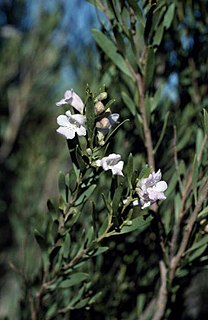
Eremophila freelingii, commonly known as limestone fuchsia or rock fuchsia bush, is a flowering plant in the figwort family, Scrophulariaceae and is endemic to Australia. It is a shrub with sticky, hairy, lance-shaped leaves and flowers a shade of light to dark lilac and which occurs in Queensland, New South Wales and South Australia.

Eremophila decipiens, commonly known as slender fuchsia bush or narrow-leaved fuchsia bush is a flowering plant in the figwort family, Scrophulariaceae and is endemic to an area extending from the south-west of Western Australia to southern parts of South Australia. It is low, sprawling shrub with lance-shaped leaves and red, orange or yellow flowers on a long, S-shaped stalk.

Eremophila miniata, commonly known as kopi poverty bush, or plumridge is a flowering plant in the figwort family, Scrophulariaceae and is endemic to Western Australia. It is an erect shrub with many tangled branches, greyish leaves and flowers which vary in colour, ranging from reddish to yellow or cream.
Eremophila cordatisepala is a flowering plant in the figwort family, Scrophulariaceae and is endemic to areas of Queensland and the Northern Territory in Australia. It is a small grey shrub with purple to lilac-coloured flowers which have heart-shaped sepals at their base.
Eremophila elderi, commonly known as aromatic emu bush, is a flowering plant in the figwort family, Scrophulariaceae. It is endemic to central Australia where it grows near the border between Western Australia, South Australia and the Northern Territory. It is an erect, aromatic shrub with sticky leaves and branches and usually pale coloured to white flowers. Its specific epithet (elderi) honours an early Australian businessman, Thomas Elder.
Eremophila falcata is a flowering plant in the figwort family, Scrophulariaceae and is endemic to Western Australia. It is a widely distributed shrub with distinctive curved leaves and white, lilac-coloured or pink flowers.

Eremophila gibsonii is a flowering plant in the figwort family, Scrophulariaceae and is endemic to Australia. It is a sticky, glabrous, rounded shrub with narrow leaves and white to lilac-coloured flowers and which occurs in Western Australia, South Australia and the Northern Territory.

Eremophila granitica, commonly known as granite poverty bush and thin-leaved poverty bush is a flowering plant in the figwort family, Scrophulariaceae and is endemic to Western Australia. It is an erect, open shrub with sticky, narrow leaves and with lilac-coloured flowers.

Eremophila incisa is a flowering plant in the figwort family, Scrophulariaceae and is endemic to Western Australia. It is a low shrub with shiny leaves which have thickened teeth along their edges and hairy, mauve or purple flowers.

Eremophila linearis, commonly known as harlequin fuchsia bush, is a flowering plant in the figwort family, Scrophulariaceae and is endemic to Western Australia. It is a shrub with long leaves, sticky, shiny leaves and branches and bright red flowers

Eremophila obovata is a flowering plant in the figwort family, Scrophulariaceae and is endemic to Australia. It is a low, compact shrub with lilac to purple flowers growing mainly in the Northern Territory and Queensland but also Western Australia, South Australia and New South Wales.

Eremophila paisleyi is a plant in the figwort family, Scrophulariaceae and is endemic to Australia. It is a rounded, broom-shaped shrub with white or lilac-coloured flowers which occurs in Western Australia, South Australia and the Northern Territory.
Eremophila pendulina is a flowering plant in the figwort family, Scrophulariaceae and is endemic to Western Australia. It is a tall, spindly, weeping shrub with narrow leaves and purple, mauve or white flowers in autumn and early spring.
Eremophila petrophila is a flowering plant in the figwort family, Scrophulariaceae and is endemic to Western Australia. It is a tall, erect, open shrub with rough branches, narrow, sticky leaves and pale lilac-coloured flowers.

Eremophila platythamnos, commonly known as desert foxglove, is a flowering plant in the figwort family, Scrophulariaceae and is endemic to Australia. It is an erect shrub with short, broad leaves and purple, mauve, blue or pink flowers.
Eremophila prostrata, commonly known as Rainbow Valley fuchsia bush, is a flowering plant in the figwort family, Scrophulariaceae and is endemic to the Northern Territory. It is a prostrate shrub with glabrous branches and leaves and purple flowers. It occurs as a few scattered populations with a total area of less than 50 ha.

Eremophila purpurascens, commonly known as purple eremophila, is a flowering plant in the figwort family, Scrophulariaceae and is endemic to Western Australia. It is an erect, bushy shrub with warty leaves and spotted, pink to red flowers.
Eremophila succinea is a flowering plant in the figwort family, Scrophulariaceae and is endemic to Western Australia. It is an erect, broom-shaped shrub with sticky, narrow, hooked leaves, narrow, sticky sepals and hairy, pale purple or mauve petals.
Eremophila viscimarginata is a flowering plant in the figwort family, Scrophulariaceae and is endemic to Western Australia. It is a small, erect, prickly shrub with hairy stems, small leaves, greenish-pink sepals and mauve petals.

Eremophila willsii is a flowering plant in the figwort family, Scrophulariaceae and is endemic to Australia. It is an erect shrub with bright green, often serrated leaves and pinkish to deep pinkish-purple petals. It is mainly found in Western Australia, the Northern Territory and South Australia in deep sand.













